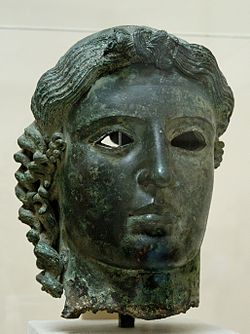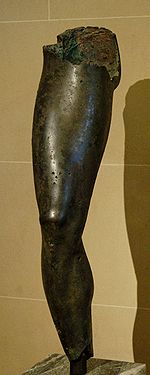- Chatsworth Head
-
The Chatsworth Head 
Year c.460 BC Type Cast bronze Dimensions 31.6 cm (12.4 in) Location British Museum, London The Chatsworth Head is a slightly over-life-size bronze head dating to around 460 BC which is now in the British Museum.
Contents
Description
The head was originally part of a complete statue, probably (judging by the shoulder-length curly hair) one of Apollo, made up of various sections (e.g. head, arms, legs, some of the locks of hair) produced separately by lost-wax casting then joined into one whole - a leg from the same sculpture is in the Louvre (Br 69). Its eyes probably originally held glass, marble or ivory inlays, which were held in with surviving bronze plates, which curl outwards to form eyelashes. Its lips seem to have been plated with reddish copper to imitate their natural colour.[1]
Discovery
In 1834 The Louvre managed to purchase the first large bronze statue found in modren times after its discovery in Italy near the Island of Elba. Two years later a complete statue was discovered near Tamassos on Cyprus and this immediately retirieved by locals who dragged it from its position using oxcarts. During its journey the statue fell apart losing legs, arms and its torso.[2]
Provenance
The head was acquired by the 6th Duke of Devonshire at Smyrna from H.P. Borrell in 1838.[3] The other parts of the statue were lost, but it is believed that a leg in the was originally part of this statue.[2]
The 6th Duke of Devonshire and his successors kept it at their residence of Chatsworth House, from which it takes its name. It was loaned to the Fitzwilliam Museum in the mid-1930s, and was acquired from the 11th Duke by the British Museum in 1958. It has the British Museum catalogue reference 1958 0418 1 and is on show there, in Room 15.
Curious feature of the head
A small, lateral section of the rear of the head at the eye level has been removed in a way which implies that it was meant to allow light to pass to illuminate the eyes of the statue. It may be that the head was positioned so as to take advantage of this feature in a temple, or the position of the sun at a given time of the year, but this is speculative.[citation needed]
References
- ^ bronze head of Apollo: the 'Chatsworth Head', British Museum, accessed August 2010
- ^ a b Greek bronze statuary: from the beginnings through the fifth century B.C., Carol C. Mattusch, p.3, 1988, accessed August 2010
- ^ 'The Chatsworth Head', A. J. B. Wace, The Journal of Hellenic Studies, Vol. 58, Part 1 (1938), pp. 90-95, accessed August 2010
External links
- Bronze head of Apollo: the 'Chatsworth Head', British Museum
- A. J. B. Wace, 'The Chatsworth Head', The Journal of Hellenic Studies, Vol. 58, Part 1 (1938), pp. 90-95
Bibliography
- D.E.L. Haynes, The technique of Greek Bronze (Mainz am Rhein, 1992)
- C.C. Mattusch, Greek Bronze statuary (Cornell University Press, 1988)
- L. Burn, The British Museum book of G-1, revised edition (London, The British Museum Press, 1999)
Categories:- Apollo
- Greek and Roman objects in the British Museum
- 5th-century BC Greek sculptures
Wikimedia Foundation. 2010.

